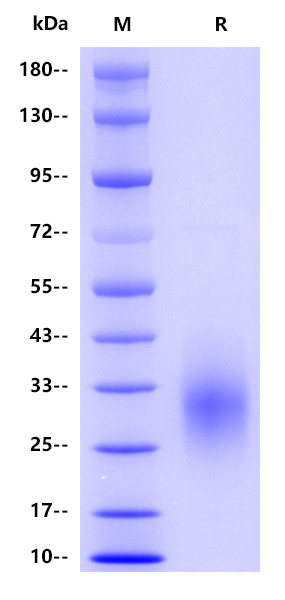Protein sequence(Q7Z6A9, Lys31-Arg157, with C-10*His) KESCDVQLYIKRQSEHSILAGDPFELECPVKYCANRPHVTWCKLNGTTCVKLEDRQTSWKEEKNISFFILHFEPVLPNDNGSYRCSANFQSNLIESHSTTLYVTDVKSASERPSKDEMASRPWLLYRGGGGSHHHHHHHHHH
12 months from date of receipt, -20 to -70 °C as supplied. 6 months, -20 to -70 °C under sterile conditions after reconstitution. 1 week, 2 to 8 °C under sterile conditions after reconstitution. Please avoid repeated freeze-thaw cycles.
B- and T-lymphocyte attenuator or BTLA (also known as cluster of differentiation 272 or CD272) is a protein that belongs to the CD28 immunoglobulin superfamily (IgSF) which is encoded by the BTLA gene. BTLA is broadly expressed in various organs. Among these are the lymph nodes, the thymus and the spleen where high expression of BTLA can be found. It is very similar in structure to PD-1 and CTLA-4. Therefore, it consists of an extracellular domain, a transmembrane domain and a cytoplasmic domain. The cytoplasmatic domain is indispensable for signalling and it is constituted of 3 important motives: the growth factor receptor-bound protein-2 (Grb-2) recognition motif, the immunoreceptor tyrosine-based inhibitory motif (ITIM) and the immunoreceptor tyrosine-based switch motif (ITSM). In many cases BTLA expression is connected with unfavourable outcomes as it, for instance, inhibits the function of human CD8+ cancer-specific T cells. However, some studies have shown that, for instance, colorectal carcinoma is associated with lower BTLA expression and that the lower BTLA expression is connected with poor survival. Hence, it seems that BTLA has rather a context-specific function. This fact should be taken into account if BTLA is to be used as a cancer therapy target.

Immobilized Human BTLA/CD272, His tag at 4 μg/mL (50 μL/well) can bind HVEM/TNFRSF14 Fc Chimera, Human (UA010664) with EC50 of 0.031-0.048 μg/ml.
